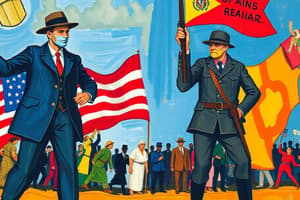Podcast
Questions and Answers
Define Imperialism and cite two examples.
Define Imperialism and cite two examples.
Imperialism is the policy by which stronger nations extend economic, political, or military control over a weaker territory/people. Examples include America's involvement in Hawaii and Cuba.
Explain the three justifications for American Imperialism between 1880-1917.
Explain the three justifications for American Imperialism between 1880-1917.
The three justifications are Economic Interests, Military Interests, and Belief in Cultural Superiority.
Name the places the US acquired after the Civil War.
Name the places the US acquired after the Civil War.
Hawaii, Alaska, the Philippines, Guantanamo Bay, Cuba, Guam, Puerto Rico, and Panama.
What is Yellow Journalism, and who were key figures behind it?
What is Yellow Journalism, and who were key figures behind it?
What violent event sparked the Spanish-American War?
What violent event sparked the Spanish-American War?
Where was the Spanish-American War fought?
Where was the Spanish-American War fought?
Trace Theodore Roosevelt's involvement in the Spanish-American War.
Trace Theodore Roosevelt's involvement in the Spanish-American War.
What were the results of the Spanish-American War?
What were the results of the Spanish-American War?
Explain the Anti-Imperialist League and name four famous members.
Explain the Anti-Imperialist League and name four famous members.
Explain the Open Door Policy of 1899.
Explain the Open Door Policy of 1899.
Explain the Boxer Rebellion.
Explain the Boxer Rebellion.
Why did Theodore Roosevelt want to build the Panama Canal?
Why did Theodore Roosevelt want to build the Panama Canal?
Explain the Roosevelt Corollary to the Monroe Doctrine.
Explain the Roosevelt Corollary to the Monroe Doctrine.
What is the Great White Fleet and what is its purpose?
What is the Great White Fleet and what is its purpose?
Flashcards are hidden until you start studying
Study Notes
Imperialism Defined
- Imperialism is the policy of stronger nations extending control over weaker territories to exploit resources.
- Examples include the annexation of Hawaii for a naval base and sugar production and the US control of Cuba leading to Guantanamo Bay.
Justifications for American Imperialism (1880-1917)
- Economic Interests: Aimed at increasing US prosperity through trade and resource acquisition.
- Military Interests: Establishment of military presence in strategic locations.
- Belief in Cultural Superiority: The notion that American government, culture, and race are superior, accompanied by a desire to spread democracy.
Territories Acquired Post-Civil War
- Key acquisitions include Hawaii, Alaska, the Philippines, Guantanamo Bay, Cuba, Guam, Puerto Rico, and Panama.
Yellow Journalism
- A sensationalist journalism style aimed at boosting newspaper sales through exaggerated news stories.
- Prominent figures like Joseph Pulitzer and William Randolph Hearst exploited sensationalism, particularly regarding Spain’s treatment of Cubans.
Spark of the Spanish-American War
- The explosion of the USS Maine served as a catalyst for the war, with Yellow Journalism promoting the belief that Spain was responsible.
Locations of the Spanish-American War
- The conflict involved battles in the Philippines (naval) and the Caribbean (naval and land).
Theodore Roosevelt's Role
- Roosevelt served in the Department of the Navy before resigning to join the war effort.
- He organized the Rough Riders, a volunteer cavalry unit that gained fame at the Battle of San Juan Hill.
Outcomes of the Spanish-American War
- Spain relinquished control of Puerto Rico, Guam, the Philippines, and Cuba to the US.
- The Platt Amendment allowed US intervention in Cuban affairs and established Guantanamo Bay as a naval base.
- Puerto Rico became a US territory with appointed officials overseeing governance.
Anti-Imperialist League
- Formed to oppose US treatment of Spain’s former colonies, advocating for governance "with the consent of the governed."
- Notable members included Jane Addams, Andrew Carnegie, Mark Twain, and Samuel Gompers.
Open Door Policy (1899)
- Proposed by Secretary of State John Hay, it aimed to ensure no single nation monopolized trade in China.
- Most involved nations accepted the policy.
Boxer Rebellion
- Led by the "Boxers," a Chinese group opposed to foreign influence and disrespect for their traditions.
- The uprising in 1900 resulted in violence against foreigners, requiring a coalition of international forces to suppress it.
Theodore Roosevelt and the Panama Canal
- Roosevelt sought the canal to enhance access between the Atlantic and Pacific Oceans, avoiding the lengthy journey around South America.
Roosevelt Corollary to the Monroe Doctrine
- Introduced in 1904, it positioned the US as the regional "policeman" in Latin America to protect American interests.
- Built on the Monroe Doctrine of 1823, which warned European powers against further colonization in the Americas.
Great White Fleet
- The Great White Fleet was a battleship fleet launched by Roosevelt to demonstrate US naval strength.
- Its deployment responded to Japanese military successes and aimed to assert US presence globally.
Studying That Suits You
Use AI to generate personalized quizzes and flashcards to suit your learning preferences.




